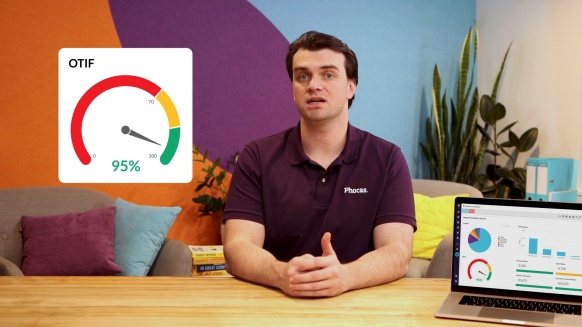Delivery in full on time: Why it matters and how you can improve

DIFOT (Delivered In-Full, On-Time) or OTIF (On-Time In-Full) is a fundamental KPI when analyzing the performance of your supply chain. The main goal is to get your customers the products they need, when they need them, in the quantity they ordered. DIFOT measures how successful your business is at achieving this objective and identifies procurement problems and supplier reliability.
It would be unthinkable for a business not to measure sales figures and cash flow and it should be equally unthinkable for manufacturing or distribution businesses not to manage DIFOT.
DIFOT is simply the number of orders that were delivered on time, with the right quantity of the correct products, on the day that the customer required them.
If you delivered 50 customer orders on a particular day and 42 were delivered on time in full; the DIFOT rate is 84% (hint, not very good).
How can DIFOT be used?
Customer satisfaction
DIFOT is a simple measurement of delivery performance from the point of view of the customer. Were their orders shipped on time, and did their orders contain everything they expected?
If you’re a distributor, your DIFOT scores could be used to promote your company’s excellent service.
Supply chain management
DIFOT scores can be used to measure the performance of your suppliers. You might be interested in understanding the suppliers that are always late with the supply of stock. Or finding which suppliers are getting your order to you on time but not the quantity you ordered.
Using DIFOT to check those lead times ensures that when contract renewal time comes around — you are well informed — about supplier performance across all of your products.
What impacts DIFOT?
Appropriate stock levels underpin customers getting their products delivered in full on time. The ability to meet purchase requirements is important for customer retention.
- Understock – carrying too little stock can put a real dent in your DIFOT. Forecasting when you might have too little stock can be tricky. Factors including seasonal trends, industry trends, customer buying habits and supply lead times can all impact stock levels.
- Human error – everyone makes mistakes, but they can be costly. Human error can include miscounting, misreading or misplacing part of an order. Once this occurs, your DIFOT will take a hit.
- Disorganized warehouse – running an inefficient warehouse can be costly. Constantly fixing mistakes or losing orders can mean you are forever playing catch-up. If your company is receiving endless phone calls regarding shipment mistakes, it’s time to consider how your warehouse is being run.
- Manufacturing fault – if a product is broken, tampered with or simply not up to satisfactory levels, it can’t be sent out. If you don’t have enough of that type of product in storage it will impact DIFOT.
Whatever it might be that is impacting your in full, on time performance, effectively tracking supply chain and monitoring what might be causing leakage can help get things back on track.
Getting DIFOT right
Using complex spreadsheets to track your supply chain performance can be time consuming and error prone. Instead, smart companies are investing in business intelligence solutions to better manage inventory levels and order fulfilment rates.
Supply chains are complex so distributors and manufacturers need tools to help them understand inventory in real-time so you can quickly adjust demand-forecasting and improve planning accuracy.
Most organizations already know what their DIFOT percentage is, but the key is being able to easily pinpoint what the issues are when they occur, and why.
A business intelligence platform lets you ask questions of your data to find out when DIFOT occurs and when it doesn’t. You can drill down and discover the products that have been causing you to not DIFOT, for example, and then take appropriate measure to fix the problem.
A BI and FP&A solution can improve DIFOT performance
A BI and FP&A solution such as Phocas helps you measure DIFOT and pinpoint areas of your supply chain that need improving. Once you know the issues holding up your ability to DIFOT, you can address them.
- Issues with the product? It’s time to talk to the supplier
- Recurring human error? Now you know you need to improve processes
- Stock being mixed and/or lost? Perhaps it’s time to address warehouse efficiencies
You don’t have to be a spreadsheet expert to use Phocas. Anyone can monitor the metrics and key performance indicators that are important to their part of the business. A whole-of-business-solution that helps you get answers to your pressing questions in seconds, bringing together data from across the business into one source of truth.

Craig is an expert in data analytics helping customers determine specific data requirements so they can enhance performance, productivity and confidence.

Using data to plan for the impact of tariffs and further change
Tariffs are here. Whether you're in manufacturing, distribution or retail, it's important to understand how importing from affected countries such as Canada, Mexico or China or chosing local production, can affect your bottom line. We want to encourage you to scenario plan now not retrospectively.
Read more
The best financial KPIs for the distribution industry
Finance professionals in distribution businesses face a persistent challenge. That is to effectively blend operational and financial data to gain a complete picture of company performance. Traditional financial ratios often exist in isolation, making it difficult to assess the broader impact of operational decisions on financial outcomes.
Read more
Key sales KPIs for distribution companies
Managing sales in a distribution business without measuring key performance indicators (KPIs) is like maintaining your home without tools or a schedule. You don’t notice a leak until the damage is severe. Instead of making progress, you waste time searching for the right tools or calling an expert for simple fixes. Without the right KPIs, inefficiencies can go unnoticed, leading to cashflow issues and lost sales.
Read more
Essential KPIs every distribution company executive should measure
For mid-market leaders running a wholesale distribution business, data and business intelligence technology are crucial for monitoring financial and operational performance. However, the real value lies in how your team uses the data insights to influence decision-making.
Read more
Find out how our platform gives you the visibility you need to get more done.
Get your demo today
